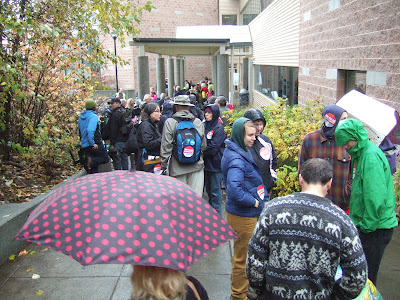I attended the EIS (environmental impact statement) scoping meeting in Bellingham. This was the first meeting since the proposed Cherry Point Coal Terminal submitted final applications. This issue is a huge deal locally in Whatcom County but has global significance as well. The proposal is to build a very large coal export terminal to export United States coal from the Powder River Basin (geologic basin) to China.
This issue has been and will likely continue to be well covered by media locally and nationally so I have generally left it alone of late on Reading the Washington Landscape unless I have something else to add.
And I should add that I attended as a volunteer to help with organization (follow orders) and to comment on the scope of the EIS regarding train issues and CO2.
One minor drama missed in the media coverage was the booth issue. Opponents of the terminal had been told no rallies, microphones or booths were to be set up on school grounds. Hence, when terminal applicant employees set up a booth some minor drama followed.
GPT (Gateway Pacific Terminal) set up tents and info booths at 6:30 am
School District informs GP that booths and tents are not allowed
Police follow up saying the tents have to go.
This was really a tough event for these employees. GPT had been running full page adds in the daily paper and radio adds all week, they got up early in the dark to set up booths, and almost no one came in support of the terminal.
The other pre meeting entertainment was the sign war. Terminal opponents had lined the street with signs. This was followed by a counter sign installation.
Coal terminal opposition lined street with signs
Counter sign installation being documented by AP reporter (and me)
This meeting was heavily attended. An Ecology staff person with a counter counted 1,800 people. Not sure if records are kept regarding EIS scoping meeting, but I would not be surprised if it was a record of some sort.
Wayne (Whatcom County) directs traffic after lower lot is full
Lined up for the meeting
Waiting to get in
But EIS scoping meetings are not just about numbers (although that does matter). The Scope of the EIS is about substance. And this part of the meeting was truly impressive. I have been through scoping meetings as a citizen, a consultant and as a panelist determining the EIS scope. I have never seen anything as close to the level of of sophistication of EIS scope comments as I witnessed yesterday. The people commenting were not paid experts or paid staff. These are just regular folks that have studied the issues that they believe need to be evaluated in the EIS. Whatcom County has become a bunch of policy wonks.I spoke with a number of people I know that have been through these types of processes and all were equally impressed. We came away proud of our community.
I can not possibly touch on all the comments, but will provide three highlights.
The first speaker
The first speaker spoke about PM 10 and PM 2.5 and health risks associated with diesel emissions. PM? particle emissions and the number refers to particle size. There was a comment much later that brought this issue into more than an abstract concept. With very long trains hauling coal shorter trains with engines running must park at sidings at various locations along the rail route and in some cases this will be right next to where people live. The particulate emissions then turn into an episodic point source for those on nearby properties.
Agency folks listening to comments
Watching the agency folks listening brought back memories. This group appeared attentive and have a long job ahead of them. This was the first scoping meeting. There are nine more at various locations around the State of Washington.
Duane impressed to crowd but also made a very valid point regarding the Scope of the EIS
Duane pointed that the proposal to export huge volumes of coal is counter to the problem that scientific consensus has reached on CO2 and global warming and that this issue must be addressed in the EIS. It is this issue that has turned this terminal proposal into more than a local issue, but a global one.
Lummi witness
A pregnant woman almost always makes for a compelling witness - they are symbolic of the future. This woman though really woke people up. She started out speaking for about 15 seconds in a language other than English. She was spoke Lummi. Her being a "Lummi witness" is a distinction that is critical to how the Lummi People view this project.
Early on I had noted the PR campaign that had been launched by the terminal proponents
coal-terminal-preemptive-strike. The one thing I conclude definitively regarding the coal terminal proposal is that the PR campaign has not worked. Yes, the usual "build anything" crowd will support this project, but a PR campaign was not needed for that group. But the reality is in the comment session I attended comments that could be categorized as opposed or very concerned was 48-1.







































